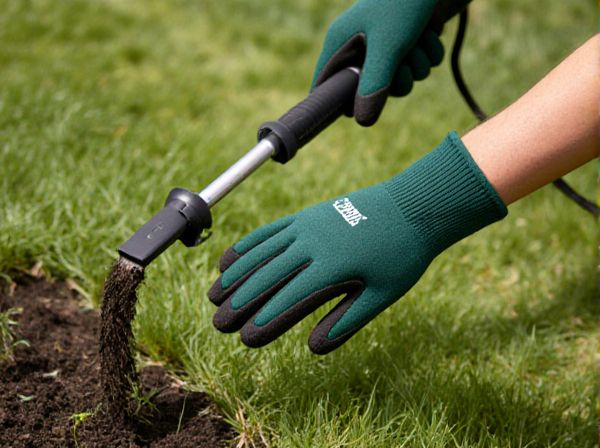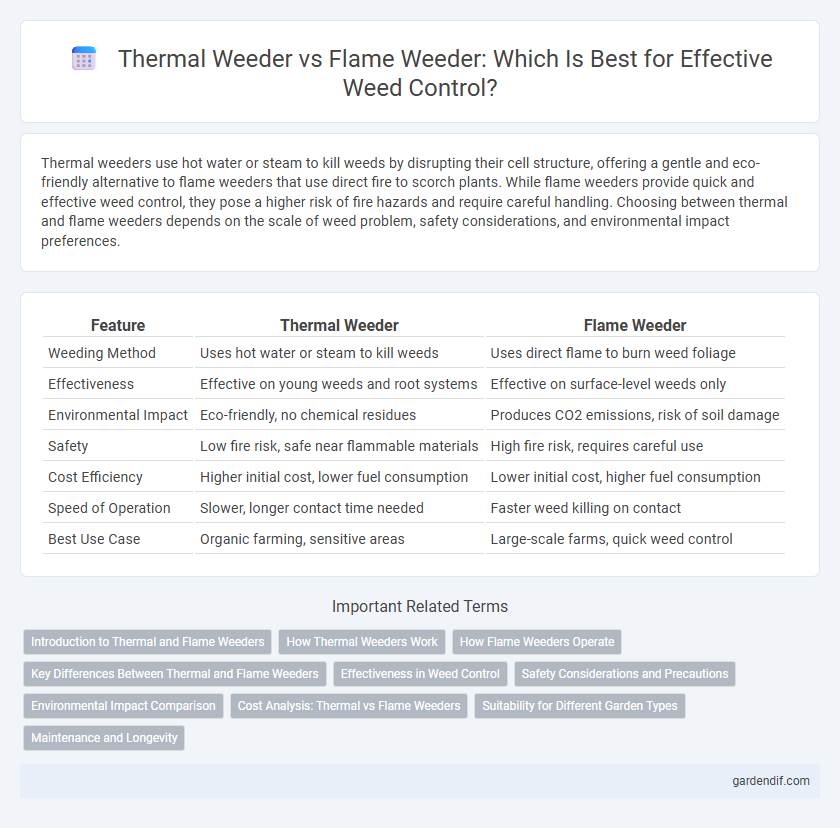
Thermal weeder vs flame weeder Illustration
Thermal weeders use hot water or steam to kill weeds by disrupting their cell structure, offering a gentle and eco-friendly alternative to flame weeders that use direct fire to scorch plants. While flame weeders provide quick and effective weed control, they pose a higher risk of fire hazards and require careful handling. Choosing between thermal and flame weeders depends on the scale of weed problem, safety considerations, and environmental impact preferences.
Table of Comparison
| Feature | Thermal Weeder | Flame Weeder |
|---|---|---|
| Weeding Method | Uses hot water or steam to kill weeds | Uses direct flame to burn weed foliage |
| Effectiveness | Effective on young weeds and root systems | Effective on surface-level weeds only |
| Environmental Impact | Eco-friendly, no chemical residues | Produces CO2 emissions, risk of soil damage |
| Safety | Low fire risk, safe near flammable materials | High fire risk, requires careful use |
| Cost Efficiency | Higher initial cost, lower fuel consumption | Lower initial cost, higher fuel consumption |
| Speed of Operation | Slower, longer contact time needed | Faster weed killing on contact |
| Best Use Case | Organic farming, sensitive areas | Large-scale farms, quick weed control |
Introduction to Thermal and Flame Weeders
Thermal weeders utilize high temperatures to disrupt the cellular structure of weeds, causing rapid cell rupture and plant death without disturbing the soil. Flame weeders employ an open flame to heat weed tissues selectively, targeting surface vegetation while minimizing damage to surrounding plants. Both methods provide chemical-free weed control options, promoting sustainable agriculture and organic farming practices.
How Thermal Weeders Work
Thermal weeders control weeds by exposing them to intense heat that causes cell fluids within the plant to vaporize, leading to cell rupture and plant death without harmful chemicals. Unlike flame weeders that use open flames to burn weeds, thermal weeders utilize hot water, steam, or infrared radiation to transfer heat more evenly and minimize fire risks. This method effectively disrupts weed growth by targeting the plant's physiology rather than combusting it, promoting eco-friendly weed management.
How Flame Weeders Operate
Flame weeders operate by applying intense heat through a propane-fueled flame to the surface of unwanted plants, causing cell walls to rupture and plants to wilt without burning the soil. This method is effective in killing young weeds by rapidly raising temperature to 160-190degF (70-90degC), disrupting the weed's internal structure. Unlike thermal weeders that use hot water or steam, flame weeders provide immediate heat contact, ensuring quick weed desiccation and minimal soil disturbance.
Key Differences Between Thermal and Flame Weeders
Thermal weeders use hot water or steam to kill weeds by denaturing plant proteins, while flame weeders apply direct heat through an open flame to destroy weed cells. Thermal weeders offer precise application with minimal fire risk, making them ideal for sensitive areas, whereas flame weeders provide quick, intense heat suitable for large-scale or robust weed control. Both methods are effective chemical-free alternatives but vary significantly in safety, operational complexity, and environmental impact.
Effectiveness in Weed Control
Thermal weeders utilize high heat to disrupt weed cell structure, providing effective control especially on young and shallow-rooted weeds, while flame weeders apply direct flame to quickly desiccate weed foliage, offering rapid results primarily for surface-level weed management. Studies indicate thermal weeders achieve higher long-term weed suppression due to sustained soil heating, whereas flame weeders may require more frequent applications to maintain control. Selecting between thermal and flame weeders depends on target weed species, growth stage, and desired treatment frequency for optimized weed management.
Safety Considerations and Precautions
Thermal weeders use hot water or steam to destroy weeds, offering minimal fire risk and safer operation around dry or flammable vegetation compared to flame weeders, which rely on direct flames that require strict fire prevention measures and constant supervision. Operators of flame weeders must use protective gear, maintain a safe distance from combustible materials, and monitor weather conditions to avoid accidental fires. Choosing a thermal weeder reduces the likelihood of burns and fire hazards, making it a safer option for use in sensitive or fire-prone environments.
Environmental Impact Comparison
Thermal weeders use hot water or steam to target weeds, significantly reducing chemical usage and minimizing soil disturbance, which helps preserve soil health and microbial diversity. Flame weeders utilize propane-fueled burners to heat weed tissues, releasing greenhouse gases and potentially increasing fuel consumption and carbon emissions. Overall, thermal weeders present a more eco-friendly alternative by lowering environmental contamination and promoting sustainable weed management practices.
Cost Analysis: Thermal vs Flame Weeders
Thermal weeders typically incur higher upfront costs due to advanced technology and fuel requirements but offer precise application and lower long-term labor expenses. Flame weeders have lower initial purchase prices and use readily available propane but may involve higher fuel consumption and safety risks, increasing operational costs over time. Evaluating total cost of ownership, including maintenance, fuel, and efficiency, is crucial for selecting between thermal and flame weeders.
Suitability for Different Garden Types
Thermal weeders are effective for delicate garden beds with close plant spacing due to their controlled heat application, reducing damage risk to desirable plants. Flame weeders deliver intense heat suitable for large, open areas like driveways or gravel paths where precision is less critical. Gardeners should select based on plant sensitivity and garden layout to maximize weed control without harming surrounding vegetation.
Maintenance and Longevity
Thermal weeders typically require minimal maintenance with periodic checks on electrical components and heating elements to ensure efficient performance. Flame weeders demand regular fuel inspections and burner cleanings to prevent clogging and maintain consistent flame output. Both tools can offer durability, but thermal weeders often have a longer lifespan due to fewer moving parts and no reliance on combustible fuels.
Thermal weeder vs flame weeder Infographic

 gardendif.com
gardendif.com